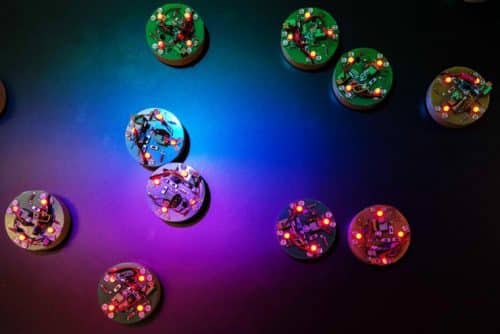New developments show “Dumb robots” can gather in compact clusters to accomplish complex tasks using smarter algorithms.
At the Georgia Institute of Technology, a team of researchers led by Dana Randall, Professor of Computing and Daniel Goldman, Dunn Family Professor of Physics, have shown how simple robots can accomplish tasks with much higher complexity levels. Imagine having a simple robot performing multiple tasks and keeping you at ease.

The team worked with simple – “dumb robots” as they call, to accomplish a set of tasks by leveraging the robot‘s physical characteristics. The team referred to this as the “task embodiment.” By removing all sensors, communication, memory and computation, and instead operating only through the task embodiment method, they were able to attain results that exceeded their expectations.
The simple BOBbots (behaving, organizing, buzzing bots), are named after granular physics pioneer Bob Behringer, explains Randall. “Their cylindrical chassis have vibrating brushes underneath and lose magnets on their periphery, causing them to spend more time at locations with more neighbours.” The set-up of this study was a combination of experimental platforms supported by precise computer simulations.
According to the researchers, BOBbots, despite being simple could move and bump into each other to form clusters.” compact aggregates form that is capable of collectively clearing debris that is too heavy for one alone to move,” according to Goldman. “While most people build increasingly complex and expensive robots to guarantee coordination, we wanted to see what complex tasks could be accomplished with very simple robots.“
Published in the journal Science Advances, the study explains the adoption of a theoretical concept of a self-organizing particle system to develop a mathematical and practical model of the BOBbots. Using ideas from probability theory, statistical physics, and stochastic algorithms, they were able to prove that the theoretical model undergoes a phase change as the magnetic interactions increase. As a result, it could abruptly start changing from dispersed to aggregating in large, compact clusters, similar to phase changes we see in common everyday systems just like water and ice.
“The rigorous analysis not only showed us how to build the BOBbots using smarter algorithms but also revealed an inherent robustness of our algorithm that allowed some of the robots to be faulty or unpredictable,” says Randall.
The idea of “Do Simple-achieve complex” has long been lost in the urge of development. The Georgia Institute of Technology study is an eye-opener to all designers: Why make things complex, when it can be done simpler using smarter methods.






